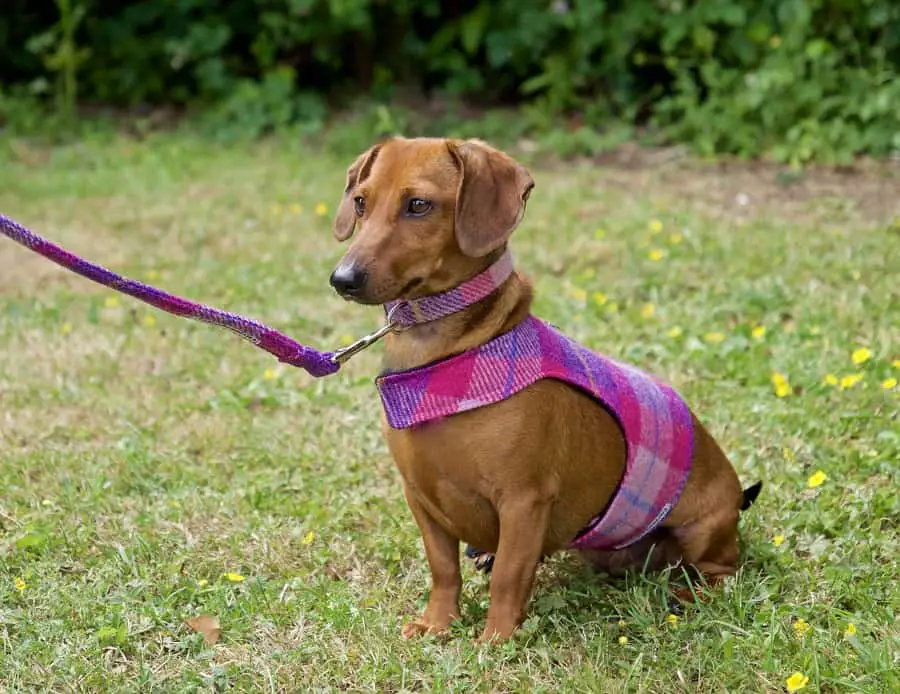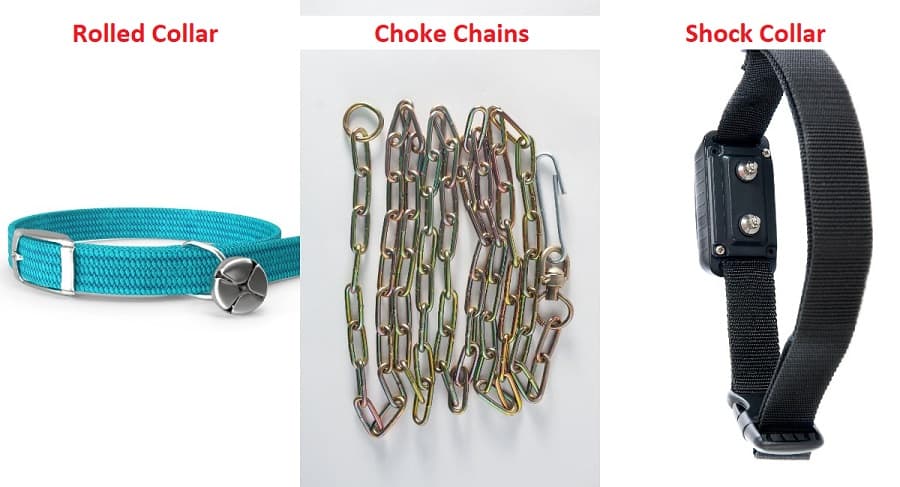For most aspects related to caring for dachshunds, if you do a bit of research you will quickly begin to see some consensus among experts and experienced owners.
But there is one topic that continues to remain contentious: Should you use a harness or a collar for your dachshund?
Even after asking around and probing through the corridors of online advisory forums, you are unlikely to come out with a convincing answer in favor of or against either option.
As you will see in this post, both harnesses and collars have certain pros and cons.

There is no fixed rule and you need to reach an informed decision based on your dog’s requirements.
The ideal option is to invest in at least one good harness and one good collar, as each serves different important functions.
Through this post, we intend to help you reach a decision by considering the most important factors involved.
In the process, you will also understand why this debate is so difficult to settle one way or the other.
Health
This is understandably the most important factor when making any decision in relation to your dog.
You want to ensure your dachshund’s physical and psychological well-being, and the choice between a collar and a harness can seem to have a strong bearing on it.
As we will see though, there isn’t always a clear winner.
Neck safety is the primary reason why many owners swear by harnesses.
This is easy to understand why, especially if your dog tends to tug hard at its leash during a walk or if you might have to suddenly yank at the leash to avoid a hazard.
A collar focuses the entire force that your dog pulls, at the leash with, onto the small area it covers around the neck.
This can result in a tremendous amount of pressure on this delicate part of the body.
Despite this discomfort, your dachshund would continue to pull because its hunting instincts are too strong – at that particular moment the thrill of pursuing a quarry or unearthing a hidden stash of food can be too powering for the pain to register.
So it’s you who needs to be conscious of the negative effects on the dog’s neck, which can vary from temporary bruising to long-lasting damage to the trachea or the larynx.
Dachshunds have tracheas that are even more sensitive than those in many other breeds, making the problem more acute.
On the other hand, a harness takes the pressure away from your dachshund’s sensitive neck and evenly spreads it over a wider area.
Even if the dog were to tug very hard, the greatest pressure would be felt by the chest, which is significantly stronger than the neck.

A harness seems to score over a collar on this point for sure.
Intervertebral disk disease (IVDD) is a serious ailment seen more commonly in dachshunds than other breeds.
Because of the breed’s unique skeletal structure, a dachshund’s spine is at particular risk to damage caused by even mild force.
Vets often recommend harnesses for dachshunds that have had episodes of IVDD in the past.
But this is meant to minimize the risk of any further shock to an already sensitive vertebral column, and not a blanket endorsement of harnesses over collars.
While cervical IVDD is one of the ways in which this problem can affect your dog, it has been found that a vast majority of disk herniations actually take place towards the middle or lower back.
This means that the stress induced by a collar on the neck is not directly responsible for IVDD seen in most dachshunds.
A clear verdict under this point becomes more difficult when you realize that many dachshund breeders proactively advise against using harnesses.
A harness presses tight against the dachshund’s sensitive back and can induce trauma.
Dachshunds that are made to wear harnesses for long periods have been known to develop arched backs and peculiar gaits.
Soreness or chafing is another common issue with a harness, especially if it is too tight or too loose.
Some areas of the dog’s body, like the armpits, are more sensitive to such effects.
If the fabric of the harness does not agree with the dog’s skin, the likelihood of a body-wide rash is also high.
Other physical ailments like prolapsed eye, malfunctioning of the nervous system, hypothyroidism, and damage to the esophagus are possible extreme effects of wrong collar use.
These are all results of pulling at the leash, and so the cause lies in the behavior rather than the accessory itself.
Safety
From the perspective of safety, a harness is a better bet. It is nearly impossible for a dog to wriggle out of a harness, no matter how hard it tries to break free and chase after a car or another dog.
Collars, on the other hand, unless you are using one of those horrible prong or shock collars (which you should not), are a poor match for your dachshund’s ingenuity.
Harnesses are also a safer option while traveling in a car – they may not be as safe as seatbelts for humans, but offer better protection, and lower chance of harm in case of jerks, when compared to a collar.
Comfort
Dachshunds are emotionally sensitive dogs and prolonged periods of discomfort can turn even the most jovial of them into under confident, morose creatures.
A collar offers your dog a greater sense of freedom, which any animal (or human) would prefer. A collar also allows the skin to breathe, which can be useful in warm weather.
A harness is much more constraining and, even if it fits your dog perfectly, can be burdensome if worn through extended periods.
Dachshunds also crave human contact, and an extra layer of fabric between its skin and its owner’s is a layer too many.
Training
Harnesses have been found to be more useful for training dachshund pups.
Because of their inquisitive and playful nature, when untrained, they will get distracted and try to pull away from you towards more interesting stuff in the vicinity.
A harness tends to discourage pulling and jumping, and helps keep the dog focused.
But, this does not always work. The relative comfort of a harness can have an unintended effect.
Since it does not ‘punish’ pulling as strongly as a collar does, a harness can end up encouraging a headstrong dog to engage in tugging and pulling.
Verdict
There could be other factors that you might need to take into consideration, like costs, availability of suitable options or the family history of your dachshund.
But, in general, as the above points show, there are sound arguments on both sides of the harness vs. collar debate.
What you might have also figured out is that many of the issues with either option arise not because of what you use on your dachshund per se.
The issues arise when your dachshund pulls and jerks during walks.
For instance, even if you use a harness instead of a collar to ensure neck safety, if your dog is not trained to walk peacefully, it will suffer from trauma to the back.
We have found that if your dachshund is healthy, it does not make a significant difference whether you use a harness or a collar.
More than anything else, it depends on your choice and your dog’s lifestyle.

Our recommendation is to let the dog keep a light collar on at all times, while putting a harness on for long walks or visits to the park where distractions are more likely.
Collars are important, and sometimes mandatory, for identification.
For best results, you have to train your dog to walk with you on a loose lead without constantly pulling ahead. This, like everything else you teach your dog, requires patience.
You need to understand your dachshund’s mentality too – it loves to explore its surroundings, the buffet of smells it is presented with every time it steps out is too enticing to not indulge in it.
So, letting it veer slightly off your set path or standing for some time at the same spot while it has its fill of the trace left by another dog will keep it from pulling the lead all the time.
An interesting method used by dog trainers is to place a backpack of appropriate weight on the dog when it goes for a walk.
The responsibility keeps the dog calm and prevents it from pulling away. You can get backpacks for dogs at pet supply stores.
Of course, whether this technique works or not depends completely on your dog’s temperament.
Knowing when the dog is in pain
Part of being a smart dog owner is knowing when to make a change to how you care for your dog by keeping an eye out for negative signs.
Any harm that your dog’s harness or collar might cause to it will manifest itself in one or more of the following symptoms:
-Bodily changes, like limping or change in posture
-Mobility issues, like difficulty in getting up, lying down or running
-Noticeable changes in the eye area, like redness, discharge, squinting or rubbing
-Behavioral changes, like irritability, restlessness, or reluctance to go out for a walk
-Respiratory issues, like persistent panting even in cool weather
-Decrease in appetite
-Changes in sleep patterns
-Changes in vocalization, like moaning, whimpering or growling
-Changes in bathroom habits, like change in posture while relieving itself
If you notice any sustained changes like the above, check with your vet.
One of the possible remedies suggested by him could be changing the harness or collar you use for your dog.
Best types of collars and harnesses

There are five common types of collars: rolled or flat collars, martingales, choke chains, prong or pinch collars, and shock collars.
Of these, the last two should be a strict no-no if you really love your dog. The best way to teach a dachshund is to reinforce positive behavior instead of harshly punishing negative activities.
A choke chain can also be very dangerous if your dog pulls a lot, and is especially discouraged for a small dog like a dachshund.
Flat collars are good, but are easy to maneuver out of. They are comfortable for wearing through the day, but not the best option when taking your dachshund out on a walk.
A martingale collar combines the best characteristics of a flat collar (comfort) and a choke chain (control).
It has two loops, the first of which acts like a regular collar that hangs around the neck without exerting pressure.
The second loop tightens when the dog pulls, but not to the extent that it chokes the dog’s windpipe.
Harnesses tend to come in wider varieties, but can be broadly divided into two categories.
The first category includes those that let you attach the leash to the front. This exerts the maximum pressure on the chest area.
The other category is of those harnesses that allow for attachment at the back.
While in general, front attaching harnesses are recommended for training dogs, for smaller breeds like dachshunds, the back attaching harness is a more comfortable option as it spreads any force over a wider area.
Ensure that no matter what kind of harness you are using, it is made of soft material and fits snugly on your dachshund’s body, without applying undue pressure on sensitive body parts like the throat and the upper back.
One size doesn’t fit all
When it comes to choosing between a harness and a collar, the decision should be dictated by your dachshund’s individual needs and the environment it lives in.
Do not hesitate to consult a vet or reliable trainer for tips.
Your aim should be to ensure comfort and safety for your dog, and provide it with regular exercise that keeps it healthy and cheerful.
